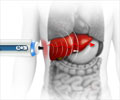
Over 5000 patients with two or more traditional CV risk factors (without previous CV events), low alcohol intake (<50g/day) and without known liver diseases (viral hepatitis, hemochromatosis, Wilson disease or drug induced liver injury) underwent carotid ultrasonography with measurement of carotid intima-media thickness (C-IMT). Carotid plaques (CP) were defined as C-IMT>1,5 mm at carotid bifurcation. The Fatty Liver Index (FLI), a surrogate marker of hepatic steatosis when >60, and the Framingham score (FRS) were calculated.
Patients with a FLI of 60 or more also had a higher BMI and increased levels of liver enzymes (ALT, AST, GGT) (p<0.0001). They also had higher C-IMT and higher FRS (0.64+0.16 vs. 0.61+0.13, p< 0,0001 and 14.7+8.8 vs. 8.3+6.6, p< 0.0001 respectively). In multivariate analysis FLI was independently associated with C-IMT (p< 0.0001) and CP (beta =0.179, p=0.01), independent of age, cholesterol level, presence of diabetes or high blood pressure.
This study demonstrated that NAFLD is highly prevalent in patients at high risk of CV diseases and is an independent predictor of early atherosclerosis and 10-years CV risk beyond classical CV risk factors. These findings strengthen the evidence that NAFLD is a heterogeneous entity requiring a multidisciplinary approach and modified screening strategies.
Type-2 diabetes and dyslipidemia are known risk factors usually associated with cardiovascular and liver-related deaths in NAFLD. A second study presented today evaluated the 10-year prognostic value of non-invasive markers FibroTest and SteatoTest for overall survival (OS), survival without liver-related death (LRD) and cardiovascular-related death (CVD) in patients with diabetes and/or dyslipidemia without known liver disease.
Over 2000 patients were prospectively followed for 12 years and mortality data collected. The study found in diabetics, regardless of associated hyperlipidaemia, FibroTest had a significant 10-year prognostic value for the overall and without liver-related death survivals. SteatoTest was also predictive of CV-related death in hyperlipidemia patients.
Both OS and survival without CVD were significantly higher in the hyperlipidemia group than in the diabetic or diabetic with hyperlipidemia group. The hyperlipidemia group with advanced steatosis (AS) tested by Steatotest had lower survival without-CVD, compared to non-AS: 97(94-99) vs. 99(98-99, P=0.004). FibroTest remained significant for the prediction of OS in the diabetic group [risk ratio (RR) = 136.9 (95%CI 11.6-1610; P< 0.0001)] and in the diabetic with hyperlipidemia group [RR=7.1 (95%CI 2.1-24; P< 0.0001)].
The study concluded that patients with type-2 diabetes, especially those with associated hyperlipidemia, presented particularly higher rates of advanced fibrosis and steatosis as well as higher overall and liver-related mortalities than those with isolated hyperlipidemia.
EASL's Education Councillor, Jean-Francois Dufour commented. "These studies reinforce the view that in patients with other risk factors such as diabetes or other metabolic impairment, the degree of liver fat deposition is an important determinant of long term mortality, not only due to liver disease progression, but other causes, particularly cardiovascular events. Although patients with NAFLD have long been known to suffer from excess cardiovascular disease, it was uncertain if this was mediated through a higher risk of earlier atherosclerotic lesions. These studies show that NAFLD is an independent predictor of cardiovascular risk."
Disclaimer: the data referenced in this release is based on the submitted abstract. More recent data may be presented at the International Liver Congress™ 2013.
Source-Eurekalert















